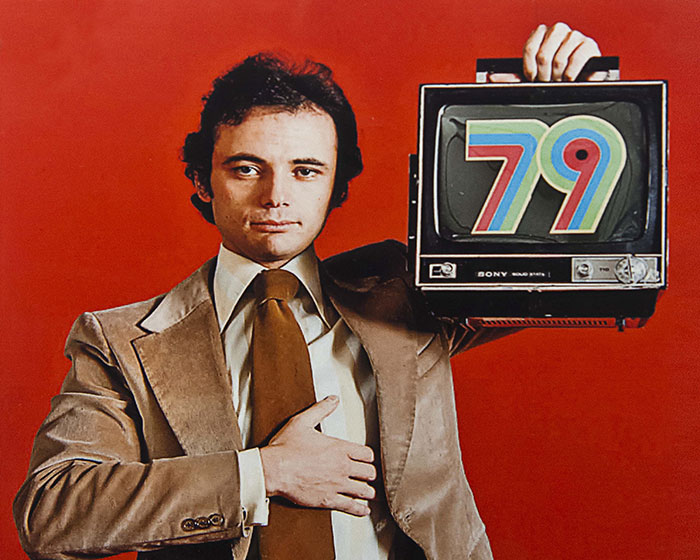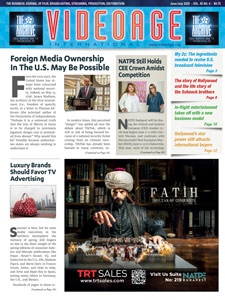Moishe (Moses) Znaimer is a media entrepreneur, media executive, media innovator, TV host, producer, content distributor, actor, TV historian, TV museum curator, TV philosopher, and prophet, who has been influencing and polarizing Canadian society since 1965, when he received a master’s degree in politics from Harvard University. But let’s start at the beginning.
Znaimer was born sometime in 1942 (he isn’t sure of the exact date), while his father, Aron, who was from Latvia, and his mother, Chaya Epelsweig, who hailed from Poland, were on a train to Kulyab in Tajik (which was then part of the USSR, but is now known as Kulob and is in Tajikistan) to escape the Holocaust, each as a sole survivor of their respective families.
After World War II ended, the Znaimers went to Poland, then West Berlin, then a Displaced Persons Camp in Hessisch Lichtenau, Germany, before finally arriving in Halifax, Nova Scotia, Canada, as refugees, in 1948. Shortly thereafter, they settled in Montreal, and eventually the young Moishe went to Toronto. This nomadic existence allowed him to be able to eruditely argue in four languages: Russian, Hebrew, French, and English. As an undergrad, he even served as president of McGill University’s Debating Union, and changed his official name from Moishe to Moses.
Znaimer documented his parents’ daring escape from the Nazis in the book Passages: Welcome Home to Canada (Doubleday Canada, 2002) by Michael Ignatieff and Rudyard Griffiths.
In its 2010 edition, The Canadian Encyclopedia reported that “Znaimer developed a reputation as the ‘bad boy of Canadian television’ due to his aggressive pursuits of opportunities, as well as his ‘aggressive sexuality,’ which the Toronto Star referred to in a 2009 [article] as his ‘most vivid personality tic.’ He is known for his tight control of his image in the media, and the way he crafts an enigmatic persona through the numerous contradictions in his work and life.”
However, the Encyclopedia continued, in 2006, “in recognition of Znaimer’s contribution to the Canadian media landscape, the City of Toronto designated the area around Citytv [the TV station that he founded] at 299 Queen Street West as Moses Znaimer Way.” The street sign wasn’t actually erected until 2008. (There is also a Marshal McLuhan Way on nearby St. Joseph Street, to honor the acclaimed Canadian media philosopher.)
For this report, VideoAge contacted three of Znaimer’s former associates, each of whom declined to explain the “challenging” relationship they had with him, while a fourth one, a 25-year veteran of Citytv, answered: “He would very quickly get frustrated by the failure of others to see and execute his vision. He got frustrated when it took an idea of his a long time to roll out. He was prepared to be wrong, but his ideas and concepts were usually very well thought through, so it would take a very solid set of arguments to move him from a position. And… he was usually right.”
Znaimer’s interest in television first manifested at age 13 when he became a naturalized Canadian citizen and used C$200 of his bar mitzvah money to buy his family a 1955 Admiral TV set. This was just three years after the inauguration of television services by the state-owned CBC. That must have left a lasting impression on him, since in 1992, 37 years after that first TV set, he founded the Moses Znaimer TV (MZTV) Museum, which has a large collection of TV cameras and TV sets dating from the early days of television that he began collecting in the 1980s and originally kept in the Citytv building. That particular Admiral TV set is not at the museum, but “there are other Admiral models in the collection, mostly from the 1940s,” he said.
Considering that this journalist wrote a book on the history of television in 1975, he quickly accepted an invitation from Znaimer to visit the MZTV Museum’s opening reception, which was held during a blizzard in December 1995 at the Royal Ontario Museum in Toronto. This reporter was also on hand in February 2014 when the museum relocated to the Liberty Village in Toronto, the same site as Znaimer’s new company, ZoomerMedia Group. Included amongst the rare artifacts were inventions by such scientists as Charles Jenkins, John Baird, Vladimir Zworykin, Lee de Forest, Boris Rosing, and Allen B. DuMont, among others. (Zworykin was one of the inventors this reporter had an opportunity to interview.)
The very first time this reporter encountered Znaimer was in 1990 during a conference in the Blue Mountains of Australia, west of Sydney. It started out rather unpleasantly as Znaimer was seated behind him and nervously kicking his chair’s legs. However, when Znaimer went up to the podium to make a presentation, this journalist quickly became a “Znaimerista,” as his followers are called, as the presentation — about innovative forms of television — was mesmerizingly funny. A feature story followed in the October 1991 issue of VideoAge after a visit to his station. However, the amusing tone of the article was not appreciated by Znaimer for whom amusement is a serious business.
Not that writing about Znaimer is easy. A Google search produced 49,400 results and it is this abundance of information about him that makes the writing harder, as there are so many discrepancies and distortions out there and it’s hard to sort them all out.
In 1990, Znaimer was running Citytv, the Toronto TV station he’d co-founded in 1972. After Znaimer left the CBC in 1969, following the rejection of an experimental program he’d proposed, Znaimer became an analyst at Helix Investments, a venture capital firm. There, he was introduced to Israel (Sruki) Switzer, chief engineer at MacLean Hunter’s new Toronto cable-TV service. At that time, Znaimer was already known nationally, having produced a popular CBC radio show, Cross Country Checkup, and co-hosted CBC TV show The Way It Is, and Take 30. He also wrote and produced a series on the history of the Russian Revolution. Znaimer started at the CBC in Toronto in 1965. Then, following a corporate dispute, he was “exiled” to Ottawa, but he returned to Toronto two years later, before leaving in 1969.
Switzer offered Znaimer the opportunity to become a partner and to create and run a local TV station that could be re-broadcast via cable. With all of the VHF television licenses in Toronto taken, the key partners –– Znaimer, Switzer’s journalist wife Phyllis, film producer Edgar Cowan, and Canadian senator Jerry Grafstein –– applied and, in 1971, were awarded the city’s first UHF commercial broadcasting license, on channel 79 (the frequency was changed to 57 in 1983). Investors included Lorne Michaels (creator of Saturday Night Live), and financier Ben Webster (Znaimer’s boss at Helix). The call letters of the station were CITY-TV, and, under the Citytv brand, they began broadcasting the following year with a C$1.5 million investment from a total of 36 investors. That was Canada’s first TV license since 1961, when CTV was created as Canada’s first private TV network with nine affiliates. Before 1961, when CTV was created, private TV stations only re-broadcast CBC programs. Citytv studios were located at 99 Queen Street East, a 15-minute walk from its former address at 299 Queen Street West, before moving to the current Yonge-Dundas Square. (Phyllis Switzer, then Citytv’s vice president, was also the mother of Jay Switzer, who passed in 2018, and who, in 2002 became the group’s president.)
Citytv became Toronto’s first independent (i.e., not affiliated) and privately owned local TV station, which, in 1996 became a “superstation” expanding its cable-TV coverage up to Ottawa.
At Citytv, Znaimer offered a distinctive style of broadcasting with a studied “casual” format aimed at young audiences. He equipped his reporters with cameras so they could shoot the stories themselves. He also hired a diverse staff, some of whom lacked TV experience, and programmed Friday night erotica. He knocked down the TV studio walls and let the passer-by public see what was happening inside. He called the concept, a “studioless station.” However, after three years, Citytv was running out of money and 45 percent of the station was sold to the Bronfman family’s Multiple Access from Montreal.
In 1977, Multiple Access sold its stake to Toronto’s CHUM — a media company founded in 1945 whose major shareholder was Allan Waters — for C$13 million. A year later CHUM increased its stake to 89.1 percent, but sold 21.9 percent to a few of the funding group (including Znaimer). In 1981, CHUM acquired the remaining 32.8 percent shares in Citytv (including Znaimer’s shares) with CHUM stock valued at C$6.4 million (Znaimer continued on as president and was later made a vice president of the parent company).
VideoAge can’t detail the financial aspects of these transactions as when asked about them Znaimer simply stated that he “didn’t exactly recall” and that the information “is not really relevant to the story.”
With Citytv’s newfound financial stability, 1981-1990 was a hugely prolific and creative period for Znaimer. During the 1990s he presided over a considerable expansion of the CHUM television group.
In 1992, Znaimer ventured outside Canada as part of a group that included Thames Television, which bid for the license for a fifth British TV channel, which was ultimately awarded to a competing consortium led by Pearson.
With expansion, however, came corporate limitations that, ultimately, in 2003, forced him out. But let’s proceed chronologically.
In 1979, two years before the birth of Music Television (MTV) in the U.S., Znaimer helped to develop John Martin’s idea of a TV version of Rolling Stone magazine. Martin (1947-2006) moved to Canada from Manchester, U.K., in 1967 to work at the CBC. His idea of a “rock and talk” TV show was accepted by Znaimer, and in 1979 The NewMusic weekly TV show was born on Citytv. With the success of the show, Martin proposed a full channel devoted to music to Znaimer. MuchMusic launched in 1984.
In 1990, Znaimer created “Speaker’s Corner,” a video booth mounted outside the Citytv building where passers-by could videotape short messages, some of which were televised. Speaker’s Corner, which lasted until 2008, pre-dated the arrival of social media — which didn’t happen until Six Degrees in 1997 and MySpace in 2003 — by a number of years, but never progressed into the social media that we know today, even though the format was licensed to TV stations in several countries, including Argentina, Colombia, Spain, and Finland.
Znaimer also predicted that television would move towards specialized channels, which prompted him to create Bravo! (a style and arts channel) in 1995, Space (a science-fiction channel) in 1997, and CablePulse 24 (Canada’s first 24-hour local news channel) in 1998. He began using the word “original” to promote programs he produced at Citytv. This was done much earlier than Netflix, which famously began using the term in 2012.
When Znaimer was (by some news accounts) forced out in 2003, CHUM had 28 radio stations, eight local TV stations and 17 specialty channels.
About the reason for his dismissal, Znaimer commented: “Creativity is about surprises. Bay Street is about no surprises.” Bay Street is Toronto’s financial district, so it is assumed that he means that his investors only cared about the bottom line.
One newspaper account at the time explained: “He was an establishment outsider who wore a ponytail and created a pioneering environment in what was becoming a mature and staid business.”
With his dismissal, Citytv’s international content distribution business was also ended. This was a business that Znaimer had started in 1991. Before closing, it had gone through three different content sales executives.
In 2007, CHUM was acquired by CTVglobemedia (now Bell Media) for C$1.4 billion, however regulators demanded that CHUM’s five Citytv local stations be sold to increase competition, and Rogers Communications purchased them for C$375 million. Citytv is now housed in Yonge-Dundas Square, while the CHUM Building — an iconic former publishing building in Toronto’s downtown that CHUM purchased in 1987 — serves as Bell Media’s headquarters.
But Znaimer did not remain idle. In addition to putting together a series of media ventures, he returned to the CBC in 2005 to executive produce the TV comedy Rumors, a show that, unfortunately, was canceled in mid-season.
Fortunately though, four years after leaving CHUM, Znaimer reconciled with the print media that he previously bashed, by acquiring control of Kemur Publishing, publisher of CARP Magazine, the print voice of advocacy association for aging Canadians.
While at Harvard he’d considered becoming a print journalist, but later, in 1995, he reneged on the medium when he produced TVTV: The Television Revolution, a three-hour documentary on the image versus the printed word that prompted him to create the “Ten Commandments of Television,” one of which (rule seven in one version, rule two in another) was “Print created illiteracy, TV is democratic.”
But after rekindling his love affair with printed journalism in 2008, he relaunched the CARP publication as Zoomer magazine. It is interesting that at a young age he promoted youth, but now, as a mature man, he has become an advocate for Canada’s 15.8 million people aged 50-plus, known in Znaimer parlance as “Zoomers” (or “boomers with zip”).
In 2006, under the ZoomerMedia umbrella (which, by the way is abbreviated as ZM, which is the reverse of MZ, Znaimer’s initials), he acquired the commercial classical radio station CFMX-FM, later re-named CFMZ-FM (for the Toronto coverage, while keeping its old call letters for its original coverage area, Cobourg, Ontario). The following year, he acquired CHWO-AM, a Toronto pop music radio station. Today, the news divisions of both stations are under the direction of his sister, Libby Znaimer, a journalist who worked for the Associated Press and Global Television, and is a national spokesperson for Pancreatic Cancer Canada (a younger brother, Sam, is a venture capitalist). Moses, on the other hand, is president of CARP, and an outspoken supporter of medically assisted dying in Canada.
In 2009, he acquired the media assets of S-VOX Foundation, for C$25 million, which included two specialty channels: The religious-oriented Vision TV, and the exercise channel One-TV, and two over-the-air stations: CHNU-TV (Joytv), and CIIT-TV (Faith TV).
In 2009, Znaimer merged his own private company MZ Media (which owned the radio stations, and a conference organization) into ZoomerMedia, which is 66.28 percent owned by Znaimer (through his Olympus Management Ltd.). Fairfax Financial, an insurance company, owns 28 percent, while the rest is floated in the TSX-V exchange. The conference organization, ideaCity, was founded in 2000. This three-day conference is held annually in the month of June, and features Znaimer as he hosts on stage some 50 prominent personalities.
ZoomerMedia and CARP are located in the ZoomerPlex, a 10,522-square-meter state-of-the-art production and live-event complex in Toronto’s Liberty Village, which also houses the 150-seat Zoomer Hall, and the MZTV Museum.
Znaimer’s work as an actor includes Louis Malle’s Atlantic City (1980), The Best Revenge (1984), and he appeared as an on camera extra in Being Julia (2004).
He’s also toiled as a theater producer. His productions included the Canadian version of Miss Margarida’s Way (1976), and Tamara (1981). Tamara was a play in which the audience followed the plot by moving from room to room, and which starred Marilyn Lightstone, his lifetime partner. They met when both were students at McGill University.
(By Dom Serafini)
Audio Version (a DV Works service)











[…] May 8, 2020 / ilanderz / 0 Comments Moses Znaimer […]